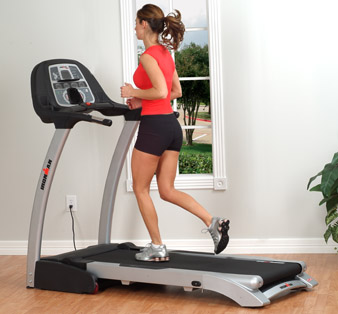I just read Haruki Murakami’s excellent little treatise on distance running called, What I write about when I write about running (title borrowed respectfully and with permission from Raymond Carver‘s estate). So here’s a disclaimer about distance: I am not talking about distance the same way Murakami is. Not by many, many miles.
When I first started to run (sort of) on the treadmill in the gym, I recall the day I managed to eek out a mile in 12 minutes. That was a huge day for me since it meant I was mostly running with only a couple of fast walk breaks. So you now have a context for what I’m talking about when I’m talking about distance.
That was about three years ago. About 2 years ago I started running outside–meaning, the ground is not mechanically moving beneath me and I actually have to propel my body forward on stationary ground. Whole new ballgame.
I started slow, a quarter mile, a half mile, with liberal walking before an after. By Spring of this year (2008) I had worked my way up to 2-2.5 miles, running continuously, with hills. This was again a major achievement and I was feeling pretty good about it. I’d learned a lot along the way, and made the decision to quit the gym and focus on running outdoors. I was clearly accustomed to the non-moving natural ground.
Sometime in June, I –with great trepidation–thought: maybe I can do a 5k. This thought was immediately followed by: What’s a 5K? When I found out it was 3.1 miles, I shied away. But the thought was there…and then the Fred Hutchinson 5 and 10K races were there, and I thought: what the hell. If it gets bad, you can always walk. So I signed up.
I practiced a 3 mile course a couple times a week for two weeks before so I figured I was ready for the 5K. I really wasn’t, but it all worked out anyway. What happens in a race, I learned, is that you get swept up by those around you, you find someone you pace with, and before you know it, you’re running a lot faster than you’ve trained, and you run out of gas somewhere in the middle. I still did okay–for me–with a 10.5 min pace. Slow by most anyone else’s standards, but better than I expected for myself (I wasn’t even sure I could finish it–it’s not the flattest course in the world).
After that race, I found my body was more or less thinking we would be running 5ks from now on, and swiftly too (for me). This goes to Murakami’s idea that you have to raise the body’s expectation of itself–you push it and back off, push and back off.
Since June, I’ve run two more 5Ks and earned some money for good organizations. One thing I found after the last one: I wasn’t happy just running anymore. In other words, running was now about racing, and I couldn’t relax and enjoy my beach and park runs like I used to. I was pushing and pushing, finding new routes, etc. I almost couldn’t hear my music anymore. What’s up with that?
So, I went back to some old routes and found I relaxed back into a better state while running and was happy again. One day, on a whim, I decided to run a slightly different route (half new, half old) which I mapped out beforehand on MapMyRun. When I actually got to the starting spot I’d picked out, there was no street sign. Thinking I’d missed it, I started where I thought it should be.
4.1 miles later, I realized I’d increased my distance…by a mile. I also realized I felt great–especially after the 3rd mile. A week later, I did the same route and found the same thing: after th 3rd mile I felt terrific–and ran even a wee bit further. Yesterday I ran it again and went 4.8 miles–nearly 5 miles. Nearly an increase of 2 miles in 2 weeks.
I’ve got a distance plan in place now, using Murakami’s idea: I go 4+ day 1, 3+ day 2, 2+ day 3, rest day 4 and by day 5 I’m itching to run–my old bod is so ready to go the new distance, it’s amazing.
So far so good–I’d like to do a 10k next summer, but I also have a deep respect for taking it a little bit at a time. After all, it’s taken me over 3 years to get here.









